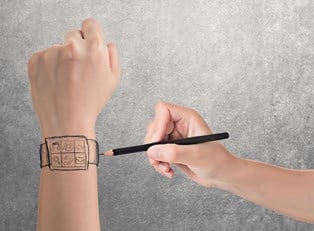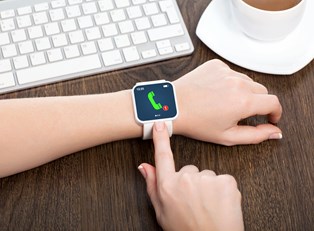It’s pretty much impossible to work out without a fitness watch these days. If you can’t count your heart rate, calorie burn, and distance, then you might as well just veg out on the couch.
I’m kidding, but I am serious about how helpful a good fitness watch is. Before you choose one though, you need to decide what you want it for. Do you want one to simply track your runs? Do you want one to wear all day to help track your overall healthy lifestyle? When you’re spending a lot of money on a fitness watch (because let’s be real, they ain’t cheap), it’s crucial to know exactly what you do and don’t want. Otherwise, you might just be wasting money.
1. Apple Watch
The Apple Watch, of course, does it all. It terms of health, an Apple Watch (both the regular and the Sport) can track your steps, heart rate, how frequently you stand up throughout the day, how well you sleep, how far you run/walk/cycle, and everything about your workout.
In addition to all the health stuff, the Apple Watch shows a whole slew of apps. Your weather, text messages, emails, and even random apps like Mint can be accessed with your Apple Watch. It takes hands-free to a whole new level in your daily life. It also accesses your music, so you can use it to change songs during your workout, while in the car, or at your desk.
Because the Apple Watch does so much, so you can only expect it to last up to 18 hours without a charge. Depending on the one you choose, an Apple Watch will cost you at least $250 (unless you can score one during a sale).
2. Fitbit Charge HR
FitBit has several different fitness watches for you to choose from, but the Charge HR has the most bang for the buck. It’s lightweight, comes in six color options, and tracks a substantial number of things for all types of workouts. First and foremost, the Charge HR is meant to track your daily steps, calorie burn, and heart rate. It does all of this within a relatively accurate range—although it can start mess up a bit if you get it wet (guilty here).
With the FitBit Charge HR, you can monitor any workout you do, including running, cycling, weight lifting, yoga, and any fitness class. During this it will track your time, how far you go, how many calories you burn, your heart rate, and the intensity of your workout. Since it’s lightweight, it doesn’t get in the way, and you’ll quickly adjust to wearing it all day. All FitBit watches connect to the FitBit smartphone app, and that’s where you can access all of the information for every day you’ve worn your FitBit. That includes your sleep quality. The battery will last you up to five days.
The Fitbit is significantly cheaper than the Apple Watch. However, it’s just a fitness watch—so capabilities beyond that only include the time, phone call notifications, and the ability to set alarms. Keep that in mind when you’re considering the FitBit Charge HR.
3. Garmin Vivoactive HR
If you’re into all the sports and activities, then the Garmin Vivoactive HR has you covered. It literally tracks every kind of exercise you could want in the best way for that activity. Most fitness watches only track your heart rate and steps/distance without consideration to the type of activity you’re doing. The Vivoactive HR has specific apps for different activities, including running, rowing, skiing, biking, swimming, and even golfing.
When you’re not out in the action, the Garmin Vivoactive HR will alert you when you need to move; it also monitors your sleep quality. In addition, it notifies you of phone calls, texts, and social media alerts, displays the weather, locates your phone when lost, and controls the music on your phone. Oh—and it’s waterproof with a battery that will last for eight days with normal, daily tracking.
4. Polar A360
Polar is known for selling top-notch sport watches. The Polar A360 is the very first to use wrist-based heart rate monitoring instead of Polar’s standard chest strap. It’s waterproof, does 24/7 activity tracking, and also comes with Polar’s activity guide. It does the same main things as the others: It tracks your sleep, steps, calories burned, general daily activity, and it has text/phone/app alerts and alarms.
It also has some benefits specific to Polar. In addition to tracking your exercise, the Polar A360 gives you feedback on how your training is improving your health and fitness, based off of what it’s recorded, comes with a Running Program (multiple distances to choose from) for you to follow, and allows you to connect to the Polar Flow app (syncs all of the watches data) and Polar Club. Polar Club is Polar’s way of connecting users from across the globe in group classes. You join a training group, follow along, and check your heart rate against others in the group.
It’ll cost you a pretty penny, but with a battery that can run for two weeks with 24/7 tracking plus one hour of exercise a day, it’s well worth it.
5. Microsoft Band 2
The Microsoft Band is much like the Apple Watch, but with the look of a FitBit. It syncs to your phone to show you emails, messages, and app notifications, controls your music, and tracks sleep, calorie burn, exercise, heart rate, and daily activity. Since it’s GPS-enabled, it can accurately follow your distance and elevation in hikes and runs, which can make all of the difference when you’re training. And if you have Windows 10, it connects to Cortana so it can help you send texts and set alerts. Microsoft Band 2‘s battery will last about 48 hours with normal use, but GPS use will run it down faster.




